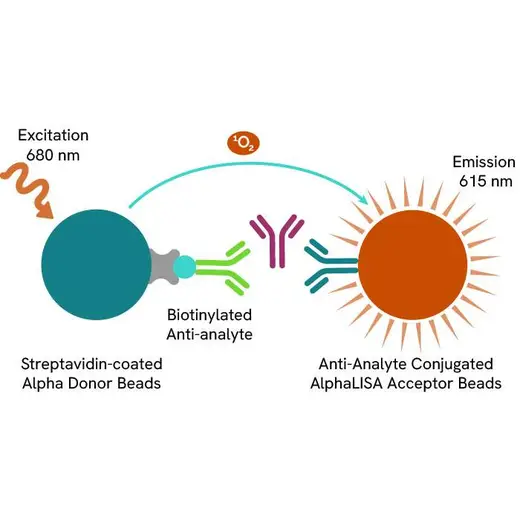
AlphaLISA Human MMP3 Detection Kit, 500 Assay Points


 View All
View All
AlphaLISA Human MMP3 Detection Kit, 500 Assay Points














The AlphaLISA™ Human Matrix Metalloproteinase-3 (MMP3) Detection Kit is designed for detection and quantitation of human MMP3 in serum, buffered solution or cell culture medium in a homogeneous (no-wash steps, no separation steps) assay. The kit was designed to detect both MMP3 and pro-MMP3.
For research use only. Not for use in diagnostic procedures. All products to be used in accordance with applicable laws and regulations including without limitation, consumption and disposal requirements under European REACH regulations (EC 1907/2006).
| Feature | Specification |
|---|---|
| Application | Protein Quantification |
| Dynamic Range | 25.8 - 300,000 pg/mL |
| Limit of Detection | 25.8 pg/mL |
| Sample Volume | 5 µL |
The AlphaLISA™ Human Matrix Metalloproteinase-3 (MMP3) Detection Kit is designed for detection and quantitation of human MMP3 in serum, buffered solution or cell culture medium in a homogeneous (no-wash steps, no separation steps) assay. The kit was designed to detect both MMP3 and pro-MMP3.
For research use only. Not for use in diagnostic procedures. All products to be used in accordance with applicable laws and regulations including without limitation, consumption and disposal requirements under European REACH regulations (EC 1907/2006).







AlphaLISA Human MMP3 Detection Kit, 500 Assay Points







AlphaLISA Human MMP3 Detection Kit, 500 Assay Points







Product information
Overview
Formats:
- Our 500 assay point kit allows you to run 500 wells in 96-well or 384-well format, using a 50 µL reaction volume (5 µL of sample).
- Our 5,000 assay point kit allows you to run 5,000 wells in 96-well or 384-well format, using a 50 µL reaction volume (5 µL of sample).
Features:
- No-wash steps, no separation steps
- ELISA alternative technology
- Sensitive detection
- Broad sample compatibility
- Small sample volume
- Results in less than 3 hours
- Half the time of an ELISA assay
Matrix Metalloproteinase 3 (MMP3), also referred to as stromelysin-1, is a 378 amino acid zinc- and calcium-dependent protease expressed by fibroblasts, endothelial cells, macrophages, osteoblasts, chondrocytes, vascular smooth muscle cells, and keratinocytes. MMP3 is secreted as a pro-enzyme (pro-MMP3) and is activated by proteolytic cleavage by serine proteases such as plasmin. The substrates for MMP3 are collagen type III, IV and V, proteoglycans, laminin, fibronectin, fibrillin, osteopontin, and gelatin. MMP3 is mainly implicated in rheumatoid arthritis disease in which it is involved in degradation of connective tissue in the synovial joint. MMP3 levels increased in serum in patients with rheumatoid arthritis disease, osteoarthritis of the hip, and certain tumors.
AlphaLISA technology allows the detection of molecules of interest in a no-wash, highly sensitive, quantitative assay. In an AlphaLISA assay, a biotinylated anti-analyte antibody binds to the Streptavidin-coated Donor beads while another anti-analyte antibody is conjugated to AlphaLISA Acceptor beads. In the presence of the analyte, the beads come into close proximity. The excitation of the Donor beads causes the release of singlet oxygen molecules that triggers a cascade of energy transfer in the Acceptor beads, resulting in a sharp peak of light emission at 615 nm.
Specifications
| Application |
Protein Quantification
|
|---|---|
| Automation Compatible |
Yes
|
| Brand |
AlphaLISA
|
| Detection Modality |
Alpha
|
| Dynamic Range |
25.8 - 300,000 pg/mL
|
| Limit of Detection |
25.8 pg/mL
|
| Product Group |
Kit
|
| Sample Volume |
5 µL
|
| Shipping Conditions |
Shipped in Blue Ice
|
| Target |
MMP3
|
| Target Class |
Biomarkers
|
| Target Species |
Human
|
| Technology |
Alpha
|
| Therapeutic Area |
Oncology
|
| Unit Size |
500 Assay Points
|
Image gallery






AlphaLISA Human MMP3 Detection Kit, 500 Assay Points






AlphaLISA Human MMP3 Detection Kit, 500 Assay Points






Video gallery

AlphaLISA Human MMP3 Detection Kit, 500 Assay Points

AlphaLISA Human MMP3 Detection Kit, 500 Assay Points

Resources
Are you looking for resources, click on the resource type to explore further.


How can we help you?
We are here to answer your questions.






























